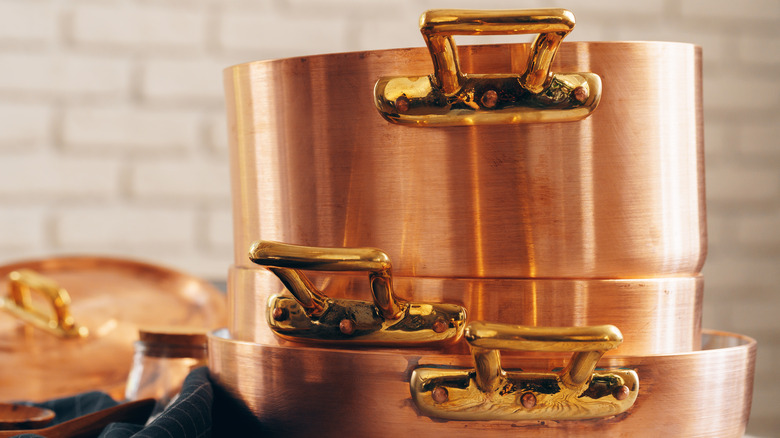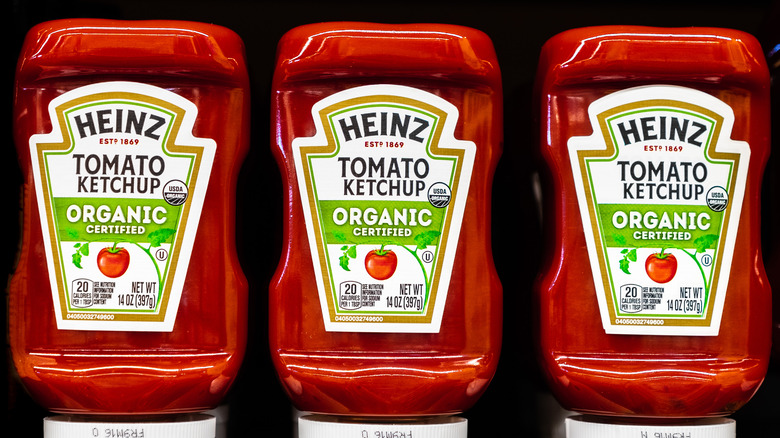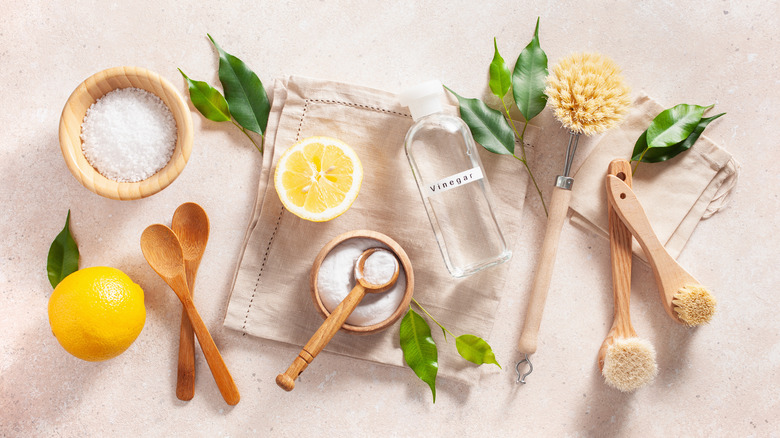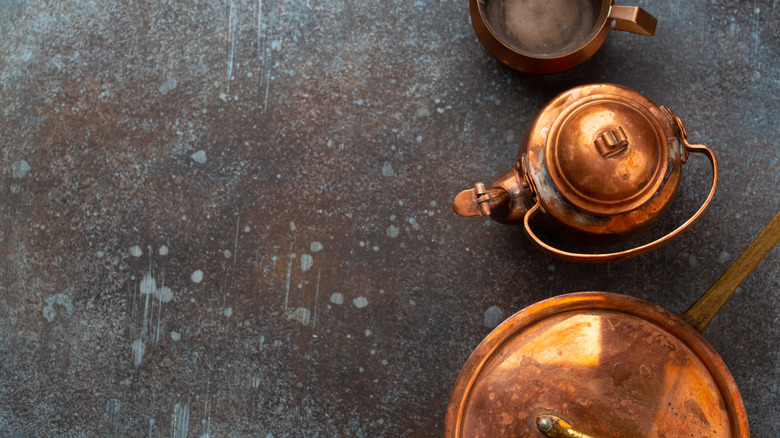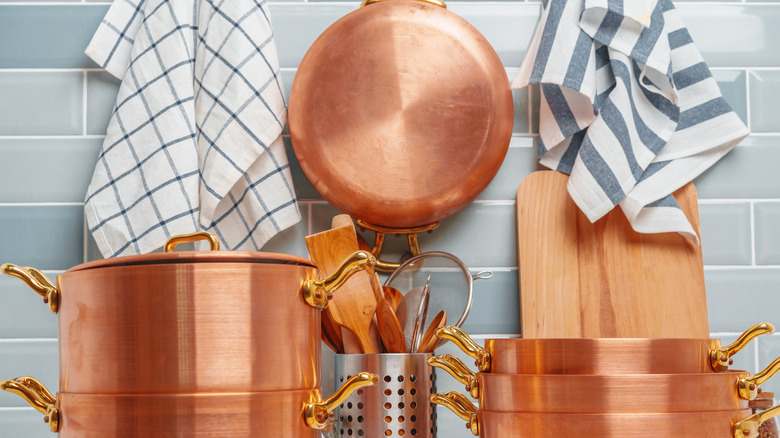You've Been Cleaning Your Copper Pots All Wrong
Copper kitchenware is elegant and timeless, with a hint of trendy flair. Copper is a look that you might not find in a traditional Farberware set. The aesthetics are a strong selling point for many at-home chefs — especially those who like to leave a decorative piece out in their kitchen — but the allure of copper is even deeper than a pretty look. According to Popular Science, this classy cookware is popular thanks to its ability to evenly disperse and control heat.
If it all sounds too good to be true, it's not — but it's certainly too good to be cheap. A 10-piece set from Mauviel can cost you $1,999. And if you think the price hurts? Copper is a soft metal with a knack for oxidizing, leaving plenty of scratches and discoloration on the surface (via Popular Science). But just because you invested in an expensive set of copper pots and pans, that doesn't mean you need to break the bank on fancy fixes. Many owners swear by Mauviel Copperbrill, but at $29.95 for a small container, it'll cost you another small fortune to clean your set.
If you're going to make an investment in a set of copper pans, then chances are, you'll be cherishing them. But no one said you had to buy copper-specific cleaning agents, or give up on the state of your set altogether — instead, trust us about these seriously helpful tidbits when it comes to caring for your copper cookware.
You might already have all you need in your fridge
Before you go submerging your copper pots and pans in the sink next to your old, dingy dishes, check your fridge. It sounds ridiculous at first (Using food to clean caked-on grime from, well, food?) but there are a few options behind your refrigerator doors that may bring your cookware back to life.
Mr. Maid's suggestion for the simplest, least aggressive clean is a bit of Worcestershire sauce. All you have to do is soak a new, gentle sponge in the sauce, then wipe down your pot and pan with it, and let it sit. The sauce will help restore that long-lost shine, as per Mr. Maid.
If you don't have Worcestershire sauce on hand, grab a bottle of ketchup instead. (Let's be real: Everyone has a bottle of ketchup in their fridge.) French Country Cottage noted that Copperbrill does the job, but so does this popular condiment due to the acidity level of tomatoes. Follow the same steps as you would with the Worcestershire sauce, but allow the pans to coat with ketchup for 15 minutes to really remove the gunk and tarnish. A couple passthroughs may be needed, so be prepared to stock up on some ketchup once you've finished with the set.
The only con? Neither fix will smell exactly like lemon zest dish soap, but the glistening end result may make your effort worth it!
Clean your copper pans with these pantry staples
There are clearly a few condiments right in your kitchen to help you clean your pots and pans, so if ketchup or Worcestershire sauce don't seem to work for you, there could still be a solution at hand!
Lemon is one of the most acidic cleaning aids available, so it makes sense to work through any oxidation with a bit of the citrusy juice. Try mixing some lemon juice with baking soda to make a thick paste, which you can then buff into your pots and pans to break through any caked-on food or wear down some of those stubborn tarnished spots. You can always try substituting the lemon juice for vinegar instead, too, according to Architectural Digest.
Martha Stewart's recommendation is taken straight from the lines of Leslie Reichert's book "The Joy of Green Cleaning," and the two are team lemon when it comes to cleaning copper. Stewart suggested using Reichert's foolproof combination: stir up 75% lemon juice and 25% salt, then wipe down your copper cookware with a gentle cloth soaked in the mixture. Reichert noted that "it's magic how it immediately removes the tarnish."
Rub — don't scrub — your copper cookware
Many people attempt an at-home fix for their copper by dipping a lemon slice directly in salt, and applying that directly to the pot or pan, but this could scratch any coatings and lead to even more tarnishing. Salt is abrasive, and any abrasive agents may lead to more harm than good (via Martha Stewart). Using undissolved salt on a copper pan is like using an original Scrub Daddy, or a Brillo pad — you may think you're working hard at the problem, but you may be making it a lot worse.
Author of "The Joy of Green Cleaning," Leslie Reichert, revealed via Martha Stewart that it's important to rub any cleaning mixtures into copper, and definitely don't scrub vigorously. Instead, dissolve the salt in the mixture beforehand, and slowly buff it into the metal.
Alternatively, you can let your copper cookware soak directly in a mixture of three cups of water, a cup of vinegar, and a tablespoon of salt — just skip any added cleaning agents, and your pans will be polished like new (via Martha Stewart).
Either embrace the patina, or avoid tarnish — the choice is yours
Once you have your copper pots and pans looking shiny and they are sparkling again, you have a decision to make: Either let your cookware slowly patina and take on more of a rugged look, or you keep it flashy and fancy forever.
If you're kind of feeling the worn look, we have some good news — Architectural Digest noted that patinated copper pans are actually incredibly sought-after, since chefs find them to be more "thermally efficient" as the surface hardens. (Bonus points for saving yourself some time rubbing pots with ketchup in the future, too.)
But if you want your copper set to stay fresh and look newer, then follow a few short rules: Ditch the abrasive agents and scrubbers, don't ever let your pans sit out without drying them (which can make oxidation occur a whole lot quicker, notes Food52), and consider coating your cleaned pans with a bit of mineral oil to seal the shine in, like Martha Stewart suggested. It's a small trade-off for such a trendy pay-off — especially after spending a pretty penny on your copper set ... so check, check, and check!
